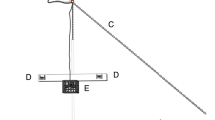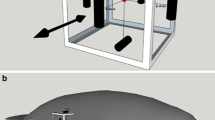Abstract
An underwater television system located off Bimini, Bahamas, was used to observe and record the attraction of free-ranging sharks to a nearby sound source. Several species of sharks were attracted by irregularly pulsed signals either containing harmonics (e.g., overdriven sine waves) or consisting of octave bands of noise. Irregularly pulsed, pure tones and harmonic sounds above 1000 Hz were apparently not attractive. Attraction was not reinforced, and habituation of the approach response was regularly observed in prolonged test series. As the number of sharks in the test area increased, swimming activity rose dramatically. Circling and crisscrossing of the site became more intense under conditions of low ambient light and turbidity. Additional tests showed that minimum attractive sound levels were remarkably low, and that sharks could locate a sound source within seconds from distances beyond our limit of visibility (about 25 m).
Similar content being viewed by others
Literature cited
Banner, A.: Evidence of sensitivity to acoustic displacements in the lemon shark, Negaprion brevirostris (Poey). In: Lateral line detectors, pp 265–273. Ed. by P. Cahn. Bloomington: Indiana University Press 1967.
Banner, A.: Attraction of young lemon sharks, Negaprion brevirostris (Poey) by sound. Copeia 1968, 871–872.
Barnes, H.: Underwater television. Oceanogr. mar. Biol. A. Rev. 1, 115–128 (1963).
Booda, L.: Industry bees swarm at NEL. Undersea Technol 7, (7), 23–25 (1966).
Coppleson, V.: Patterns of shark attack for the world. In: Sharks and survival, pp 389–419. Ed. by P. Gilbert. Boston: D. C. Heath & Company 1963.
Cummings, W., B. Bpahy and W. Herrnkind: The ocourrence of underwater sounds of biological origin off the west coast of Bimini, Bahamas. In: Marine bio-acoustics, pp 27–43. Ed. by W. N. Tavolga. New York: Macmillan 1964.
Davies, D., E. Clark, A. Tester and P. Gilbert: Facilities for the experimental investigation of sharks. In: Sharks and survival, pp 151–162. Ed. by P. Gilbert. Boston: D. C. Heath & Company 1963a.
— J. Lochner and E. Smith: Preliminary investigations on the hearing of sharks. Investl Rep. Oceanographic Res. Inst. Durban. 7, 1–10 (1963b).
Editorial Notes and News: Underwater television. Copcia 1967, 502.
Eibl-Eibesfeldt, I. and H. Haas: Erfahrungen mit Haien. Z. Tierpsychol. 16, 739–746 (1959).
Essaplan, F.: Notes on the behavior of sharks in captivity. Copeia 1962, 457–459.
Galler, S. and I. Wallen: Biological oceanography. Oceanology Int. 2 (4), 22 (1967).
Haas, H.: Diving to adventure, 280 pp. Garden City: Doubleday 1957.
Harris, G.: Considerations on the physics of sound production by fishes. In: Marine bio-acoustics, pp 233–249. Ed. by W. N. Tavolga. New York: Macmillan 1964.
— and W. van Bergeijk: Evidence that the lateral-line organ responds to near-field displacements of sound sources in water. J. acoust. Soc. Am. 34, 1831–1841 (1962).
Hobson, E.: Feeding behavior in three species of sharks. Pacif. Sci. 17, 171–194 (1963).
— J. Mautin and E. Reese: Two shark incidents at Eniwetok Atoll, Marshall Islands. Pacif. Sci. 15 (4), 605–609 (1961).
Holt, D.: Opportunities for research utilizing underwater TV and acoustic systems. BioScience 17 (9), 635–636 (1967).
Hull, S.: Those remarkable little work boats. Geo-mar. Technol. 3 (5), 22–40 (1967).
Kritzler, H. and L. Wood: Provisional audiogram for the shark, Carcharhinus leucas. Science, N. Y. 133, 1480–1482 (1961).
Kronengold, M., R. Dann, W. Green and J. Lowenstein: Description of the system. In: Marine bio-acoustics, pp 11–26. Ed. by W. N. Tavolga. New York: Macmillan 1964.
Kumpf, H.: Use of underwater television in bio-acoustic research. In: Marine bio-acoustics, pp 45–57. Ed. by W. N. Tavolga. New York: Macmillan 1964.
— and J. Lowenstein: Undersea observation station. Sea Front 8, 198–206 (1962).
La Fond, E.: The U.S. Navy Electronics Laboratory's oceanographic research tower: its development and utilization. NEL Rep. 1342, 161 pp. (1965).
Limbaugh, C.: Field notes on sharks. In: Sharks and survival, pp 63–94. Ed. by P. Gilbert. Boston: D. C. Heath & Co. 1963.
Llano, G.: Open ocean shark attacks. In: Sharks and survival, pp 369–386. Ed. by P. Gilbert. Boston: D. C. Heath & Co. 1963.
Myrberg, A., Jr., R. Stevenson and J. Steinberg: Biological considerations for the future use of the original television housing of the Bimini video-acoustic project. Tech. Rep. Office nav. Res. (ONR) 13 pp. (1966).
Nelson, D.: Hearing thresholds, frequency discrimination, and acoustic orientation in the lemon shark, Negaprion brevirostris (Poey). Bull. mar. Sci. Gulf Caribb. 17, 741–768 (1967a).
—: Comments from panelists. In: Lateral line detectors, pp 475–476. Ed. by P. Cahn. Bloomington: Indiana University Press 1967b.
— and S. Gruber: Sharks: attraction by low-frequency sounds. Science, N.Y. 142 (3594), 975–977 (1963).
Olla, B.: The perception of sound in small hammerhead sharks, Sphyrna lewini. Masters thesis, University of Hawaii 1962.
Parker, G.: Influence of the eyes, ears, and other allied sense organs on the movements of the dogfish, Mustelus canis. Bull. Bur. Fish., Wash. 29, 45–57 (1909).
Piccard, J.: The future of deep sea exploration. Oceanology Int. 1 (2), 50–53 (1966).
Rebikoff, D.: The case for unmanned underwater systems. Sea Front. 13, 130–136 (1967).
Rechnitzer, A.: Deep submersibles. Oceanology Int. 2 (4), 24–25 (1967).
Richard, J. D.: Fish attraction with pulsed low-frequency sound. J. Fish. Res. Bd Can. 25 (7), 1441–1452 (1968).
Springer, S.: Social organization of shark populations. In: Sharks, skates, and rays, pp 149–174. Ed. by P. Gilbert, R. Mathewson and D. Rall. Baltimore: The Johns Hopkins Press 1967.
Steinberg, J. and F. Koczy: Objectives and requirements. In: Marine bio-acoustics, pp 1–9. Ed. by W. N. Tavolga. New York: Macmillan 1964.
Stevenson, R., Jr.: Underwater television. Oceanology Int. 2 (7), 30–35 (1967).
Tester, A. and S. Kato: Visual target discrimination in blacktip sharks (C. melanopterus) and grey sharks (C. menisorrah). Pacif. Sci. 20 (4), 461–471 (1966).
Vilstrup, L.: Structure and function of the membranous sacs of the labyrinth in Acanthias vulgaris, 134 pp. Copenhagen: E. Munksgaard 1951.
Wisby, W., J. Richard, D. Nelson and S. Gruber: Sound perception in elasmobranchs. In: Marine bio-acoustics, pp 255–268. Ed. by W. N. Tavolga. New York: Macmillan 1964.
Wright, B.: Releasers of attack behavior pattern in shark and barracuda. J. Wildl. Mgmt 12 (2), 117–123 (1948).
Author information
Authors and Affiliations
Additional information
Communicated by G. L. Voss, Miami
Rights and permissions
About this article
Cite this article
Myrberg, A.A., Banner, A. & Richard, J.D. Shark attraction using a video-acoustic system. Marine Biol. 2, 264–276 (1969). https://doi.org/10.1007/BF00351149
Accepted:
Issue Date:
DOI: https://doi.org/10.1007/BF00351149




